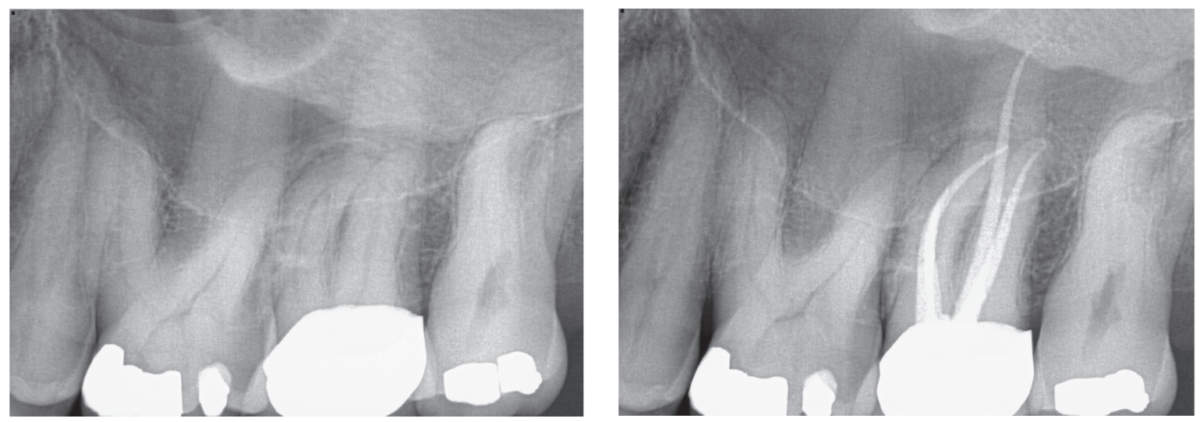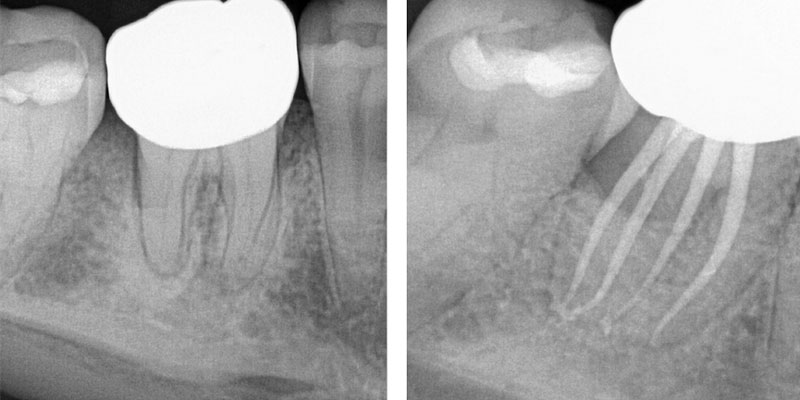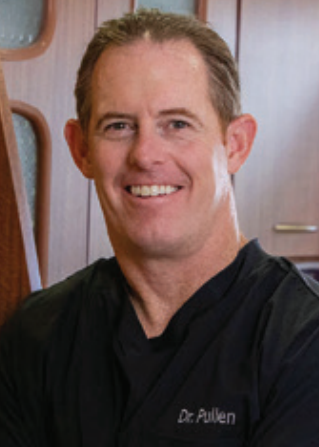CE Expiration Date: June 21, 2027
CEU (Continuing Education Unit):2 Credit(s)
AGD Code: 070
Educational aims and objectives
This self-instructional course for dentists aims to discuss an efficient technique for rotary negotiation and roto-reciprocation.
Expected outcomes
Endodontic Practice US subscribers can answer the CE questions by taking the quiz online to earn 2 hours of CE from reading this article. Correctly answering the questions will demonstrate the reader can:
- Summarize some history of the equipment used in the technique.
- Provide details on the implementation of the technique.
- Realize how to mitigate certain issues that may occur during the process.
- Identify some additional technologies for activated disinfection.
Dr. Reid Pullen discussed his hybrid technique for shaping and finishing canals using ProTaper files.
Dr. Reid Pullen introduces a protocol for shaping and finishing root canals
The goal of endodontic therapy is to remove the diseased pulp and seal the root canal system to prevent recontamination.1 To accomplish this, we must first locate all the canals, get down the canals (full negotiation), and then shape and clean the canal system.2 This involves removing the diseased pulp tissue and clearing the microbial field encased in biofilm as much as possible. This is accomplished through a chemo-mechanical approach using antibacterial irrigants coupled with hand and nickel-titanium shaping files.3
With this process in mind, a new paradigm in endodontics has occurred. With the advent of rotary negotiation files like the ProTaper Ultimate™ Slider (Dentsply Sirona) and the miniKUT 15/03 and 15/05 (Plan B Dental), clinicians can now utilize a faster approach to negotiating to the apex. Rotary negotiation is defined as negotiating down the length of the root without the use of a hand file. Roto-reciprocation can be defined as a technique where both rotary and reciprocation are employed to shape and clean the canals. This article will discuss the extremely efficient technique of both rotary negotiation using the ProTaper Ultimate Slider and roto-reciprocation using the ProTaper Gold™ S1 and WaveOne® Gold Primary to shape and finish the canals.



The ProTaper Ultimate system, introduced to the market in 2021, was designed by Cliff Ruddle, John West, and Pierre Machtou, and was created as the next evolution to the ProTaper series. It was designed to cut a minimally invasive shape and preserve pericervical dentin. In this file system, the Slider was born. This employed a newer concept of rotary negotiation. The initial testing4 with ProTaper Ultimate Slider showed that endodontists were 63% successful at negotiating down to the apex without the use of a hand file. I wanted to personally test 1) If the Slider was first successful at negotiating down to patency (the Slider had to exit out the foramen with a “long” reading on the EAL to be counted as a success), and 2) if it was safe to do so (was there a high separation rate — could the Slider ledge?).
For over a year, I kept track of every canal for which I used the ProTaper Ultimate Slider and recorded if it negotiated to patency, how many passes it took (I stopped after 3 passes), and if it separated or ledged. After testing 1,357 canals, I was able to negotiate to patency and achieve a working length by attaching the EAL clip directly to the Slider, in 1,088 canals. This is an 80.2% success rate. In this sample, I separated 4 Sliders and ledged zero canals (in my clinical opinion, the file will separate prior to ledging the canal). This is a .2947% file separation rate. Of course, any file separation is contraindicated, especially at the beginning of treatment. What I encountered was that in the four separation events, I was able to either bypass or push the separated Slider to the “side” and still reach working length. In only one case, the Slider was right at working length and I was “stuck” and unable to achieve patency. Also, all four times, I pushed on the Slider attempting to achieve full negotiation, and yet, the directions for use clearly state to employ a passive shaping technique. In other words, if the file binds or “hits a brick wall” DO NOT push and instead remove it, irrigate, and negotiate to patency using traditional hand files. I also noted that if the Slider does not advance to working length in two shaping passes, then the chance of it reaching on the third is rare. So after this period of testing (once I reach 1,500 canals), I will only try the Slider in 2 passes, and if I am unable to reach patency, then I will use a No. 8 or No. 10 K hand file with a 45° apical bend and negotiate in the traditional method.

After conducting research with the ProTaper Ultimate Slider and successfully negotiating to patency 80% of the time, I then experimented with a hybridized shaping system consisting of using the ProTaper Gold Shaper 1 (Dentspy Sirona) to prepare the middle 1/3 shape, and then following that with reciprocation using the WaveOne Gold Primary (Dentsply Sirona) to finish the apical shape. If a canal had a larger foramen than a No. 25 (tip size of the WaveOne Gold Primary), then I would “upshape” or “plus it” to a WaveOne Gold Medium (No. 35 tip).

In performing this technique on over 1,000 cases, I quickly realized the extreme efficiency of this technique. In most cases, I shaped the canal system so fast that I had plenty of time to use activated disinfection, either SWEEPS laser irrigation (LightWalker® laser, Fotona) or the sonic SmartLite Pro EndoActivator™ (18,000 cycle per minute) (Dentsply Sirona). This technique has reduced my shaping fatigue, has increased my shaping efficiency, and has made clinical endodontics more enjoyable (after 18 years of private endodontic practice, it is imperative that we continue to enjoy the process).
In closing, the ProTaper Ultimate Slider has completely changed the way I negotiate to the apex. In over 1,300 cases I have been successful at reaching the apex and beyond 80% of the time. In the majority of these cases, I am able to negotiate to patency, achieve an accurate working length, and an open glide path (three key endodontic pillars) in seconds. I then follow this up with a hybridized roto-reciprocation technique using the ProTaper Gold S1 to shape the middle third and then the WaveOne Gold Primary to shape the apical third. This roto-reciprocation technique also shapes the majority of canals in just minutes. I now have plenty of time to activate and enhance irrigation with different devices on the market or let the sodium hypochlorite or Triton (Brasseler USA) soak in the canals while I am diagnosing and anesthetizing another patient. All in all, I have been using this new hybridized roto-reciprocation technique for the last year and a half, and it has increased my shaping efficiency, simplified my technique, and has made root canal therapy enjoyable.
References
- Ørstavik D.Materials used for root canal obturation: technical, biological and clinical testing. Endod Topics. 2006; 12(1):25-38.
- Schilder H. Cleaning and shaping the root canal. Dent Clin North Am. 1974 Apr;18(2): 269-296.
- Nair PN. Pathogenesis of apical periodontitis and the causes of endodontic failures. Crit Rev Oral Biol Med. 2004 Nov 1;15(6):348-381.
- Internal study. Dentsply Sirona. 2021.
Stay Relevant With Endodontic Practice US
Join our email list for CE courses and webinars, articles and more..

 Reid V. Pullen, DDS, graduated from USC Dental School in 1999. He completed an advanced education in general dentistry in 2000 while serving in the Army Dental Corps in Landstuhl, Germany. He graduated from the Long Beach VA Endodontic Residency in 2006 and opened a private practice in Brea, California, in 2007. Dr. Pullen founded and runs Rootcanalacademy.com and The 2 Day Root Camp Boot Camp. Dr. Pullen became a Diplomate of the American Board of Endodontics in 2013.
Reid V. Pullen, DDS, graduated from USC Dental School in 1999. He completed an advanced education in general dentistry in 2000 while serving in the Army Dental Corps in Landstuhl, Germany. He graduated from the Long Beach VA Endodontic Residency in 2006 and opened a private practice in Brea, California, in 2007. Dr. Pullen founded and runs Rootcanalacademy.com and The 2 Day Root Camp Boot Camp. Dr. Pullen became a Diplomate of the American Board of Endodontics in 2013.